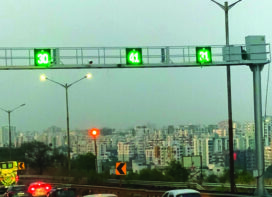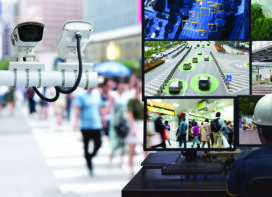 Improving and reforming highways to ultimately bring in growth and prosperity has been a constant endeavour of nearly every nation. Highway means traffic, and more importantly, its Speed, Skill, Stamina and Safety (four S). To support the movement of wheels several authorities from Public, Private plays an important role both at National/International level.
Improving and reforming highways to ultimately bring in growth and prosperity has been a constant endeavour of nearly every nation. Highway means traffic, and more importantly, its Speed, Skill, Stamina and Safety (four S). To support the movement of wheels several authorities from Public, Private plays an important role both at National/International level.
Technology is the most important contributor in the four S – it benefits transportation and also benefits the highway agencies, commuters and the motorists. Intelligent Transportation System (ITS) enhances mobility by reducing the idle time of motorists and thereby, decreasing emission; and increasing fuel efficiency. As the predominant factors of safety and security are put in place, faster emergency assistance, traffic redirection through Discrete Traffic Algorithm and improvement & reliability on highway safety systems soon follow. This is an integral part of National Security Response Strategy. Thus, it brings the ROI for the Concessionaires, thereby initiating more on BOT & PPP. The Government’s significant support through SPV’s plays a major role here.
The Toll Management System (TMS) began initially with Semi-Automatic Tolling and progressed to fully Automatic Tolling system along with Electronic Tolling. It didn’t stop there because soon it progressed to Multi Lane Free Flow System. The next challenge in this area will be the government initiative of reformed strategies towards the National Highway Corridor and collaboration through interoperability of toll. The Idea of Green Toll as an important step towards Carbon Credit is already in place.
The current Tolling Systems in India perform with 10 major integrated equipment. They include Lane Status Display, Lane Management with Boom Barriers, User Fare Display, Automatic Vehicle Classifier (AVC), Plaza Control System, Surveillance, Smart Card based Electronic Toll Collection ETC through Microwave/Infrared RFID based Tolling and Touch & Go System. Now-a-days, Weigh in Motion (WIM) is also seen at integrated plazas. The same has the future role as Pre AVC since it provides not only the Axle Count but also the Load on each Axle. This will restrict the wrong classification by toll collectors since the TMS includes AVC post human classification. Further, NHAI is initiating a policy through which the concessionaires can charge higher toll for vehicles that are overloaded.
Similarly, Toll Back Office for Central Monitoring and Consolidation has come to play a major role in the case of public safety. Concessionaires are even going in for proper Business Continuity Plan (BCP) and relevant DR. Thus, Toll System in India is ready to take the modern route through innovative strategies and efficient technologies.
The procedure
The process of a vehicle passing through a toll plaza is as follows:
When a vehicle approaching a toll plaza is about 1000 metres or 500 metres away from it – it gets the first information about the upcoming Toll Collection Plaza through the (i) Signages. Through the signages, the motorist also comes to know the different rates for different classes of vehicles, and sometimes, even the rates for the monthly/daily pass. Now, the motorist forges ahead and finds the (ii) Lane Status Display Units. From there, he proceeds towards the (iii) Booth. All this while, he is not aware that the number of Axles of his vehicle are being counted along with the load on each Axle through the Load Sensors — a device placed below the ground on the path called (iv) Weigh in Motion (WIM).
NHAI is initiating a policy through which the concessionaires can charge higher toll for vehicles that are overloaded. Similarly, Toll Back Office for Central Monitoring and Consolidation has come to play a major role in the case of public safety.
The (v) Lane Engine notes the information and keeps it ready at the backend. When the motorist stops at the booth for paying the toll to the toll collector who has manually classified the vehicle and calculated the Lane Engine Charges Toll, the ticket is generated. As the money gets collected and the toll collector gives the manual instruction, the Lane Engine sends the signal to the (vi) Boom Barrier which opens up automatically — showing the driver the toll that has been charged and also green signal to proceed through vii) User Fare Display Unit (UFD). It doesn’t end here. (viii) The Automatic Vehicle Classifier (AVC), through its PLC, works in the background to classify the vehicle automatically based on the inputs of (ix) Profiler & (x) Height Sensors planted on both sides of the lane. If the toll collector’s classification matches with the AVC’s classification, the transaction gets completed as valid and gets transmitted to the (xi) Plaza Application System along with the video recording of the vehicle movement through the lane passing the booth and as recorded by the (xii) Surveillance Cameras. In case of a mismatch between AVC and Manual classification, the same becomes an incident and a snap of the same is also taken which goes to the (xiii) Plaza Controller System. The plaza controller, as the in-charge of the classification process, either does the final settlement or completes it as a violation.
 The procedure is slightly different in case of an ETC: (xiv) An On Board Unit (OBU), which is normally fitted on the dash board of the vehicle, is plugged in with the (xv) Smart Card. The smart Card has an online xvi) e Purse that can be read by the (xvii) Reader in the lane based on which the journey value gets deducted. The settlement happens online with the backend system and the vehicle is allowed to proceed. The backend system, which can be considered as (xviii) Back Office, can also be integrated with a (xix) Payment Gateway which can be used by the vehicle owners or transport companies to top up several smart cards with multiple journey values.
The procedure is slightly different in case of an ETC: (xiv) An On Board Unit (OBU), which is normally fitted on the dash board of the vehicle, is plugged in with the (xv) Smart Card. The smart Card has an online xvi) e Purse that can be read by the (xvii) Reader in the lane based on which the journey value gets deducted. The settlement happens online with the backend system and the vehicle is allowed to proceed. The backend system, which can be considered as (xviii) Back Office, can also be integrated with a (xix) Payment Gateway which can be used by the vehicle owners or transport companies to top up several smart cards with multiple journey values.
The same Smart Card and OBU based transactions, through multiple lanes, can be considered as (xx) Multi Lane Free Flow System (MLFF). In this system, the lanes are ideally Qfree and toll collection happens at the speed of 40kms/hr and above depending on the vehicle movement in the lanes.
The last but not the least, there can be a proposition for non OBU but (xxi) Touch & Go System where the Smart Cards (Contact/Contact less) can be provided to commuters as monthly passes which can be topped up through (xxii)Point of Sale (POS) at the toll plazas – they can be used by Flashing or Touching the (xxiii) Smart Card Reader at the lanes too. As a future endeavour WIM, which can be considered as a (xxiv) Pre Toll Classification Unit, can be used for charging the overloaded vehicles at the rate off the next higher category. However, to make the same lanes Qfree and for the satisfaction of the drivers about the actual overload of the vehicle, the same can be diverted to (xxv) Static Weigh Bridge zone ahead of the Plaza. This will also bring in direct ROI to concessionaires on the implementation of WIM in the lanes.
Challenges
Antiquated toll transactions and violation processing systems hurt revenues. They slow down the cash flow and erode the bottom line. Customer services are often inconvenient to use and too slow to respond. Old and fragmented technology platforms are very inflexible when it comes to managing the evolving complexities of modern toll facilities. To cater to this need, the predominant solution of integrated (xxvi) bCentral Control System is necessary. Some of its highlights are
- Easy to use and intuitive web interfaces
- Integrated customer service and violations, image-based transaction processing
- Most of the business rules are encapsulated within the stored procedures in the database
- Access to all application features is through a single user sign-in
- PCI DSS
- Confidential information is displayed as masked
- Redesigned image review process based in OCR confidence that reaches up to 2.400 reviews/hr
Finally, to go ahead with these procedures, it is necessary that the concessionaires proceed with a proper Business Continuity Plan through strategic Security Systems, Archiving and DR.
(Prince Mitra has two decades of exprience in tolling operation.Apart from India, he has worked in Germany,South Africa, Malaysia, Pakistan and Dubai.)
 TrafficInfraTech Magazine Linking People Places & Progress
TrafficInfraTech Magazine Linking People Places & Progress



